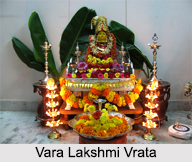 Vara Lakshmi Vrata is an important puja performed by women in the states of Karnataka, Andhra Pradesh and a lot of parts of Tamil Nadu. This festival is also known as `Mahalakshmi Vrata` and is observed on the second Friday of the bright fortnight in the month of Asadhav or Shraava?a, which corresponds to the English months of July-August. The Vara Lakshmi Vrata literally meant the worship of goddess who grants the boon.
Vara Lakshmi Vrata is an important puja performed by women in the states of Karnataka, Andhra Pradesh and a lot of parts of Tamil Nadu. This festival is also known as `Mahalakshmi Vrata` and is observed on the second Friday of the bright fortnight in the month of Asadhav or Shraava?a, which corresponds to the English months of July-August. The Vara Lakshmi Vrata literally meant the worship of goddess who grants the boon.
Myths of Vara Lakshmi Vrata
As per myths, Vara Lakshmi was incarnated from the milky ocean. There was a Brahmin woman, named Charumathi in a town namely Kundina in Magadha. Impressed by her attachment to her family, Goddess Lakshmi appeared in her dream and asked her to worship Vara Lakshmi and look for to carry out her wishes. Vara Lakshmi is yet one more form of Lord Vishnu`s wife, Lakshmi. When Charumathi described her dream to her family, she found them encouraging her to carry out the puja. A number of other women of the village joined her in performing the puja in a traditional way and presented a lot of sweet dishes to the Goddess Vara Lakshmi. There are many legends behind the Vara Lakshmi Vrata. This puja was pronounced by no other than Lord Shiva himself to be performed by his consort Parvati to bring the prosperity and happiness for their divine family.
Rituals of Vara Lakshmi Vrata
Vara Lakshmi Vrata is performed by a woman whose husband is still alive. It is performed in a precise time or "lagna" for long-lasting wealth. It is done to achieve children, for the health and long life of the husband. After a bath, the lady should put on a clean, fresh cloth and make a "mandala" (spiritual symbol in Hinduism) with the drawing of a lotus upon it. A "kalasha" filled with rice and topped with fresh mango leaves, a coconut and cloth are placed on the "mandala". Fresh grains are used in the worship as they express the idea of growth and wealth.
After the worship of the "kalasha", follows the worship of Ganesha, then the worship of the sacred thread. The main worship of Vara Lakshmi starts and the "raksha" (sacred thread) is worshipped for a second time and then tied to the right hand of the lady. After the worship, different fortunate articles are given as charity to some deserving lady whose husband is alive.
Significance of Vara Lakshmi Vrata
There are eight forces or energies recognised in the Hindu shastras, each one of which is called a Lakshmi and all of them together are called `Astalakshmi`. They are known as "Siri" (Wealth), "Bhu" (Earth), "Saraswathi" (learning), "Prithi" (Love), "Keerthi" (Fame), "Shanthi" (Peace), "Santhushti" (Pleasure) and "Pushti" (Strength). Lord Vishnu, symbolizing the preservative aspect of the universe and radiates forces from him which are worshiped as "Lakshmis". As health, wealth and affluence depend upon the rhythmic play of these forces, the worship of Lakshmi is said to be to attain these three. This festival is observed largely by women, invoking the blessings of Lakshmi on them, their husbands and their children.




















